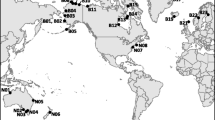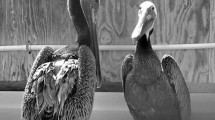Abstract
Our understanding of the annual life-cycle movements of small migratory birds has advanced rapidly with the advent of light-weight geographical positioning devices (i.e., geolocators), yet the effects of geolocators on reproduction and survival have not been adequately quantified. We tested for impacts of attaching a 1-g geolocator (using a harness around the legs and back, anterior to the tail) to adult Tree Swallows (Tachycineta bicolor) on parental feeding behavior, nestling growth and size, fledging success, and return rates between 2011 and 2012. At one breeding site, we compared feeding visits, nestling growth, and nestling size between paired nest boxes where one parent was marked at the ‘geolocator’ box with a ‘control’ nest box where neither parent was marked. We detected no differences between geolocator and control nests in either the frequency of feeding visits to nestlings or the amount of time spent at nests. Birds marked with geolocators fed nestlings as frequently as their unmarked mates. Likewise, nestlings raised at geolocator nests grew at similar rates to those at control nests, and had similar structural size and body mass at fledging. At three widely-separated sites across the Tree Swallow breeding range in Canada, we also found that fledging success was similar for geolocator and control nests. Although we found no evidence for short-term negative impacts of geolocators, the return rates of geolocator-marked Tree Swallows tended to be significantly lower than those of unmarked control birds. Thus, we found little evidence for short-term impacts of geolocators on reproduction but our study does suggest that long-term impacts of geolocators could be manifested in terms of lower survival, higher emigration rates, or lower breeding propensity.
Zusammenfassung
Der Einfluss von Geolokatoren auf Bruterfolg und jährliche Rückkehrraten eines ziehenden Singvogels
Unsere Kenntnis der alljährlichen Wanderungen kleiner Zugvögel hat mit der Einführung kleiner, leichter Geräte zur geographischen Positionierung (Geolokatoren) stark zugenommen. Allerdings wurden die Auswirkungen dieser Geräte auf Fortpflanzung und Überleben bisher nur unzureichend getestet. Wir untersuchten die Auswirkung eines 1 g schweren Geolokators (befestigt mit Gurt um Beine und Rücken, vor dem Schwanz) auf erwachsenen Sumpfschwalben (Tachycineta bicolor) auf Fütterverhalten der Eltern, Wachstumsrate und Größe der Küken, Ausfliegeerfolg und Rückkehrraten zwischen 2011 und 2012. An einem Brutplatz wurden zudem Fütterraten, Kükenwachstum und Kükengröße zwischen paarigen Nistkästen verglichen, wo an einem Nest jeweils ein Partner mit Geolokator markiert war (Geolokator-Nistkasten), am zweiten Nest jedoch zwei unmarkierte Partner brüteten (Kontrolle). Wir fanden zwischen den beiden Gruppen keine Unterschiede in der Häufigkeit der Fütterungen oder der Zeit, die Elterntiere am Nest verbrachten. Die mit Geolokator markierten Vögel fütterten ihre Küken ebenso häufig wie ihre unmarkierten Brutpartner. Küken aus Geolokator-Nestern hatten eine ähnliche Wachstumsrate wie Küken aus Kontroll-Nestern. Obwohl wir keine kurzfristigen negativen Einflüsse fanden, waren die Rückkehrraten der mit Geolokator markierten Sumpfschwalben signifikant niedriger, als die der unmarkierten Kontrollvögel. Insgesamt fanden wir wenige Hinweise, dass Geolokatoren auf kurze Sicht die Reproduktion beeinflussen, aber auf lange Sicht fanden wir, dass Geolokatoren höhere Sterblichkeit, Auswanderung oder geringere Brutwahrscheinlichkeit bedingten.


Similar content being viewed by others
References
Åkesson S, Klaassen R, Holmgren J, Fox JW, Hedenström A (2012) Migration routes and strategies in a highly aerial migrant, the Common Swift Apus apus, revealed by light-level geolocators. PloS ONE 7(7):e41195
Bächler E, Hahn S, Schaub M, Alrettaz R, Jenni L, Fox JW, Afanasyev V, Liechti F (2010) Year-round tracking of small trans-Saharan migrants using light-level geolocators. PLoS ONE 5(3):e95566
Bairlein F, Norris DR, Nagel R, Bulte M, Voigt CC, Fox JW, Hussell DJT, Schmaljohann H (2012) Cross-hemisphere migration of a 25 g songbird. Biol Lett 8:505–507
Barron DG, Brawn JD, Weatherhead PJ (2010) Meta-analysis of transmitter effects on avian behaviour and ecology. Methods Ecol Evol 1:180–187
Bortolotti LE, Harriman VB, Clark RG, Dawson RD (2011) Can changes in provisioning by parent birds account for seasonally declining patterns of offspring recruitment? Can J Zool 89:921–928
Bowlin MS, Henningsson P, Muijres FT, Vleugels RHE, Liechti F, Hedenström A (2010) The effects of geolocator drag and weight on the flight ranges of small migrants. Methods Ecol Evol 1:398–402
Boyle WA, Guglielmo CG, Hobson KA, Norris DR (2011) Lekking birds in a tropical forest forego sex for migration. Biol Lett 7:661–663
Bridge ES, Thorup K, Bowlin MS, Chilson PB, Diehl RH, Flerón RW, Hartl P, Kays R, Kelly JF, Robinson WD, Wikelski M (2011) Technology on the move: recent and forthcoming innovations for tracking migratory birds. Bioscience 61:689–698
Dawson RD (2008) Timing of breeding and environmental factors as determinants of reproductive performance of tree swallows. Can J Zool 86:843–850
Egevang C, Stenhouse IJ, Phillips RA, Petersen A, Fox JW, Silk JRD (2010) Tracking of Arctic Terns Sterna paradisaea reveals longest animal migration. Proc Natl Acad Sci USA 107:2078–2081
Elliott KH, McFarlane-Tranquilla L, Burke CM, Hedd A, Montevecchi WA, Anderson VG (2012) Year-long deployments of small geolocators increase corticosterone levels in murres. Mar Ecol Prog Ser 466:1–7
Gow EA, Done TW, Stutchbury BJM (2011) Radio-tags have no behavioral or physiological effects on a migratory songbird during breeding and molt. J Field Ornithol 82:193–201
Heckscher CM, Taylor SM, Fox JW, Afanasyev V (2011) Veery (Catharus fuscescens) wintering locations, migratory connectivity, and a revision of its winter range using geolocator technology. Auk 128:531–542
Hill RD (1994) Theory of geolocation by light levels. In: Burney J, Le Boeuf BJ, Laws RM (eds) Elephant seals: population ecology, behaviour, and physiology. University of California Press, Berkeley, pp 227–236
Hobson KA, Wassenaar L (2008) Tracking animal migration with stable isotopes. Academic, London
Hussell DH (2003) Climate change, spring temperatures, and timing of breeding of tree swallows (Tachycineta bicolor) in southern Ontario. Auk 120:607–618
Igual JM, Forero MG, Tavecchia G, González-Solis J, Martínez-Abraín A, Hobson KA, Ruiz X, Oro D (2005) Short-term effects of data-loggers on Cory’s Shearwater (Calonectris diomedea). Mar Biol 146:619–624
Jahn AE, Levey DJ, Hostetler JA, Mamani AM (2010) Determinants of partial bird migration in the Amazon Basin. J Anim Ecol 79:983–992
Kenward RE (2001) A manual for wildlife radiotagging. Academic, London
Klaassen M, Bauer S, Madsen J, Possingham H (2008) Optimal management of a goose flyway: migrant management at minimum cost. J Appl Ecol 45:1446–1452
Korner-Nievergelt F, Liechti F, Hahn S (2012) Migratory connectivity derived from sparse ring reencounter data with unknown numbers of ringed birds. J Ornithol 153:771–782
Leffelaar D, Robertson RJ (1986) Equality of feeding roles and the maintenance of monogamy in Tree Swallows. Behav Ecol Sociobiol 18:199–206
Martin TG, Chadès I, Arcese P, Marra PP, Possingham HP, Norris DR (2007) Optimal conservation of migratory species. PLoS ONE 2(8):e751
McCarty JP (2001) Variation in growth of nestling Tree Swallows across multiple temporal and spatial scales. Auk 118:176–190
Murray DL, Fuller MR (2000) A critical review of the effects of marking on the biology of vertebrates. In: Boitani L, Fuller TK (eds) Research techniques in animal ecology – controversies and consequences. Columbia University Press, New York, pp 15–64
Norris DR, Marra PP, Kyser TK, Sherry TW, Ratcliffe LM (2004) Tropical winter habitat limits reproductive success on the temperate breeding grounds in a migratory bird. Proc R Soc Lond B 271:59–64
Phillips RA, Xavier JC, Croxall JP (2003) Effects of satellite transmitters on albatrosses and petrels. Auk 120:1082–1090
Pyle P, Howell SNG, Yunick RP, DeSante DF (1987) Identification Guide to North American Passerines. Slate Creek, Bolinas
Quinney TE (1986) Male and female parental care in Tree Swallows. Wilson Bull 98:147–150
Rae LF, Mitchell GW, Mauck RA, Guglielmo CG, Norris DR (2009) Radio transmitters do not affect the body condition of Savannah Sparrows during the fall premigratory period. J Field Ornithol 80:419–426
Rappole JH, Tipton AR (1991) New harness design for attachment of radio transmitters to small passerines. J Field Ornithol 62:335–337
Reichlin TS, Schaub M, Menz MHM, Mermod M, Portner P, Arlettaz R, Jenni L (2009) Migration patterns of Hoopoe Upupa epops and Wryneck Jynx torquilla: an analysis of European ring recoveries. J Ornithol 150:393–400
Rodríguez A, Negro JJ, Bustamante J, Fox JW, Afanasyev V (2009a) Geolocators map the wintering grounds of threatened Lesser Kestrels in Africa. Divers Distrib 15:1010–1016
Rodríguez A, Negro JJ, Fox JW, Afanasyev V (2009b) Effects of geolocator attachments on breeding parameters of Lesser Kestrels. J Field Ornithol 80:399–407
SAS Institute (2003) SAS/STAT user’s guide. Version 9.1. SAS Institute, Cary
Schmaljohann H, Buchmann M, Fox JW, Bairlein F (2012) Tracking migration routes and the annual cycle of a trans-Sahara songbird migrant. Behav Ecol Sociobiol 66:915–922
Sheehy J, Taylor CM, McCann KS, Norris DR (2010) Optimal conservation of migratory animals: integrating demographic information across seasons. Conserv Lett 3:192–202
Shutler D, Clark RG (2003) Causes and consequences of Tree Swallow (Tachycineta bicolor) dispersal in Saskatchewan. Auk 120:619–631
Shutler D, Clark RG, Fehr C, Diamond AW (2006) Time and recruitment costs as currencies in manipulation studies on the costs of reproduction. Ecology 87:2938–2946
Siegel S, Castellan NJ (1988) Nonparametric Statistics for the Behavioral Sciences, 2nd edn. McGraw-Hill, New York
Stach R, Jakobson S, Kullberg C, Fransson T (2012) Geolocators reveal three consecutive wintering areas in the Thrush Nightingale. Anim Migr. doi:10.2478/ami-2012-0001
Stanley CQ, MacPherson M, Fraser KC, McKinnon EA, Stutchbury BJM (2012) Repeat tracking of individual songbirds reveals consistent migration timing but flexibility in route. PLoS ONE 7(7):e40688
Stutchbury BJM, Tarof SA, Done T, Gow E, Kramer PM, Tautin J, Fox JW, Afanasyev V (2009) Tracking long-distance songbird migration by using geolocators. Science 323:896
Tøttrup AP, Klaassen RHG, Kristensen MW, Strandberg R, Vardanis Y, Lindström Å, Rahbek C, Alerstam T, Thorup K (2012) Drought in Africa caused delayed arrival of European songbirds. Science 338:1307
Townsend JM, Rimmer CC, McFarland KP (2012) Radio-transmitters do not affect seasonal mass change or annual survival of wintering Bicknell’s Thrushes. J Field Ornithol 83:295–301
Webster MS, Marra PP, Haig SM, Bensch S, Holmes RT (2002) Links between worlds: unraveling migratory connectivity. Trends Ecol Evol 17:76–83
Winkler DW, Hallinger K, Ardia DR, Robertson RJ, Stutchbury BJ, Cohen RR (2011) Tree Swallow (Tachycineta bicolor). In: A Poole (ed) The Birds of North America Online Ithaca: Cornell Lab of Ornithology
Zach R, Mayoh KR (1982) Weight and feather growth of nestling Tree Swallows. Can J Zool 60:1080–1090
Acknowledgments
We are grateful to A.J. Green, J.A. Amat, V.B. Harriman, K.W. Dufour, H. Schmaljohann and two anonymous reviewers for constructive comments on the manuscript. Thanks to V.B. Harriman, C. McKay, D. LeClair, A. Lenske, A. McKintosh, J. Mirabelli, E. Ospina, L. Schmader, C. Soos and G. Treen for help with fieldwork. J.G. was supported by an Argo GLOBAL grant, promoted by the Spanish Ministry of Education, Culture and Sports and managed by the FICYT. Funding was provided by the Canadian Foundation for Innovation (DRN), Natural Sciences and Engineering Research Council of Canada (NSERC) Discovery Grants (D.R.N., R.D.D., R.G.C.), an NSERC IRDF Fellowship (D.W.B.), an NSERC Canada Graduate Scholarship (L.L.B.), Bird Studies Canada (D.W.B., D.R.N.), and Environment Canada (R.G.C.). Bird manipulations complied with the current laws of Canada, and animal use regulations at the University of Saskatchewan (20070041), the University of Northern British Columbia (ACUC-2011-13), and the University of Guelph (11R042).
Author information
Authors and Affiliations
Corresponding author
Additional information
Communicated by F. Bairlein.
Rights and permissions
About this article
Cite this article
Gómez, J., Michelson, C.I., Bradley, D.W. et al. Effects of geolocators on reproductive performance and annual return rates of a migratory songbird. J Ornithol 155, 37–44 (2014). https://doi.org/10.1007/s10336-013-0984-x
Received:
Revised:
Accepted:
Published:
Issue Date:
DOI: https://doi.org/10.1007/s10336-013-0984-x




